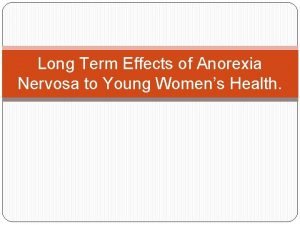Anorexia Nervosa Disorder Kate Mallory Wake Forest University

- Slides: 1

Anorexia Nervosa Disorder Kate Mallory Wake Forest University Department of Counseling ABSTRACT Anorexia nervosa is a form of eating disorder, which affects 0. 3% of the population, but only a minority of those affected are treated in mental healthcare (Hoek, 2006, p. 389). Anorexia nervosa is most well-known for the characteristic low body weight of individuals struggling with it. However, it is often accompanied by depression, obsessive-compulsive disorder, and anxiety. This literature review will provide an overview of the information available regarding this disorder and the means by which it was obtained for this paper. This information will examine the background of the disorder and its primary characteristics, which differentiate it from other psychiatric and eating disorders which share similar symptoms and the prevalence with which it affects individuals worldwide. Also discussed will be the factors and markers determined to be most helpful in diagnosis and assessment as well as the options for treatment and the strategies which have been proven to be the most effective. Finally, a discussion will be shared to express summaries of the literature, highlights in current research, and gaps to be addressed by further study. INTRODUCTION Anorexia nervosa is a feeding and eating disorder most often recognized by its core feature, “restriction of energy intake relative to requirements leading to significantly low body weight, ” as defined by the Diagnostic and Statistical Manual-V (American Psychiatric Association, 2013). METHODS Databases utilized: • Pub. Med • Psych. Info • ERIC Search strategy: • general search terms in beginning • narrower search terms later in the process • utilized gathered information to search for more specific research Key words and phrases utilized: • “anorexia nervosa” • “eating disorders” • “restrictive food intake disorder” • “adolescent anorexia nervosa” • “anorexia nervosa family” • “anorexia nervosa treatment” Additional filters utilized: • restricted search to research published after 2000 • specified results must include full-text options RESULTS Diagnosis: • significantly low body weigh • intense fear of gaining weight • disturbance of body perception • physical symptoms: leukopenia, anemia, thrombocytopenia, dehydration • psychological symptoms: “depressed mood, social withdrawal, irritability, insomnia, decreased interest in sex” (Attia and Walsh & Yager and Anderson, as cited by American Psychiatric Association, 2013) Symptoms: • Loss of appetite • Weight loss • “Disturbance in the experience of one’s body weight or shape” (Horndasch, Heinrich, Kratz, Mal, Graap, & Moll, 2015, p. 677) Diagnostic Criteria as outlined by DSM-V (American Psychiatric Association, 2013): A. Restriction of energy intake relative to requirements, leading to a significantly low body weight in the context of age, sex, developmental trajectory, and physical health. Significantly low weight is defined as a weight that is less than minimally normal or, for children and adolescents, less than that minimally expected. B. Intense fear of gaining weight or of becoming fat, or persistent behavior that interferes with weight gain, even though at a significantly low weight. C. Disturbance in the way in which one’s body weight or shape is experienced, undue influence of body weight or shape on selfevaluation, or persistent lack of recognition of the seriousness of the current low body weight. ” Risk Factors (American Psychiatric Association, 2013): • Age: most common onset in adolescence • Stressful life event(s) • Gender: more common in females • Race: more common among white individuals (Hoek, 2006, p. 389) RESEARCH POSTER PRESENTATION DESIGN © 2015 www. Poster. Presentations. com Comorbidity: • major depressive disorder • schizophrenia spectrum disorder • obsessive-compulsive disorder • avoidant/restrictive food intake disorder • bipolar disorder Causation (Fisher & Bushlow, 2015, p. 443): • biological factors (e. g. low serotonin) • social factors (e. g. popular culture) • psychological factors (e. g. need to be accepted by others) • cultural factors (e. g. industrialized national background) Assessment: • primary factor: low body weight • test for symptoms of comorbidity • tests for other diagnostic factors • screen for degree of restriction of food intake • screen for binging behavior • screen for purging behavior • determine the degree to which the individual fears gaining weight • determine the degree of accuracy with which the individual views her own body • screen to determine the individual’s perception of other women’s bodies (Horndasch, Heinrich, Kratz, Mai, Graap, et al. , 2015, p. 677) Treatment: • Clinicians should focus on: • Treating the fear of gaining weight • Dysmorphic body image • Obsessive-compulsive behavior surrounding food and weight • Research emphasizes the value of immediate weight gain immediately following the beginning of treatment • Focus on the family • Treatment settings can include one or a combination of the following: • Outpatient • Day-clinic • Inpatient (for individuals who present with a body mass index in the third percentile, continue rapid weight loss, certain complications, or severe psychotic comorbidity) (Schlegl, Diedrich, Neumayr, Fumi, Naab, et al. , 2015, p. 214). • Note: When comparing the various settings for treatment, findings “suggest that for the group of people with anorexia nervosa that is severe enough to consider inpatient care but not severe enough for this to be essential, outpatient treatment is at least as effective as inpatient treatment” (Meads, Gold, & Burls, 2001, p. 238). • Family-Based Therapy has been proven to produce positive results including “more rapid weight gain, less hospital use, and cost-[effectiveness]” (Forsberg & Lock, 2015, p. 620) DISCUSSION Based upon the information gleaned for this literature review, anorexia nervosa disorder can prove difficult to treat because of its comorbidity with “bipolar, depressive, and anxiety disorders [which] common co-occur with anorexia nervosa” (American Psychiatric Association, 2013). These “co-morbid mental disorders complicate treatment and recovery rates for youth with [anorexia nervosa]” (Wagner, Diamond, Levy, Russon, & Litster, 2016, p. 208). In addition to increasing the difficulty of treatment, these comorbid disorders may also increase the challenge of diagnosis. The literature reviewed has provided a wealth of knowledge on the subject of anorexia nervosa. Much is left to study in terms of understanding the root causes of anorexia nervosa, especially involving the role of families in treatment and the “views and opinions of parents in relation to people diagnosed with an eating disorder” (Mc. Cormack & Mc. Cann, 2015, p. 143). However, the studies have garnered information regarding warning signs, risk factors, physical and psychiatric symptoms, and treatment strategies that have advanced the understanding and increased hope for individuals with this disorder. RECOMMENDATIONS FOR FUTURE RESEARCH • Effectiveness of family inclusion in therapy • Further study to compare inpatient and outpatient settings • Study of individuals after treatment REFERENCES American Psychiatric Association (2013). Diagnostic and Statistical Manual of Mental Disorders (5 th ed. ). Washington, DC: Author. Fisher, M. , & Bushlow, M. (2015). Perceptions of family styles by adolescents with eating disorders and their parents. International Journal of Adolescent Medicine and Health, 27(4), 443 -449. Forsberg, S. , & Lock, J. (2015). Family-based treatment of child and adolescent eating disorders. Child and Adolescent Psychiatric Clinics of North America, 24(3), 617 -629. Hoek, H. W. (2006). Incidence, prevalence, and mortality of anorexia nervosa and other eating disorders. Curr Opin Psychiatry, 19(4), 389 -394. Horndasch, S. , Heinrich, H. , Kratz, O. , Mai, S. , Graap, H. , & Moll, G. H. (2015). Perception and evaluation of women’s bodies in adolescents and adults with anorexia nervosa. European Archives of Psychiatry and Clinical Neuroscience, 265(8), 677 -687. Mccormack, C. , & Mccann, E. (2015). Caring for an adolescent with anorexia nervosa: Parent’s views and experiences. Archives of Psychiatric Nursing, 29(3), 143 -147. Meads, C. , Gold, L. , & Burls, A. (2001). How effective is outpatient care compared to inpatient care for the treatment of anorexia nervosa? A systematic review. European Eating Disorders Review, 9(4), 229 -241. Schlegl, S. , Diedrich, A. , Neumayr, C. , Fumi, M. , Naab, S. , & Voderholzer, U. (2015). Inpatient treatment for adolescents with anorexia nervosa: Clinical significance and predictors of treatment outcome. European Eating Disorders Review Eur. Eat. Disorders Rev. , 24(3), 214 -222. Wagner, I. , Diamond, G. S. , Levy, S. , Russon, J. , & Litster, R. (2016). Attachment-based family therapy as an adjunct to family-based treatment for adolescent anorexia nervosa. Australian and New Zealand Journal of Family Therapy Aust N Z J Fam Ther, 37(2), 207 -227.

